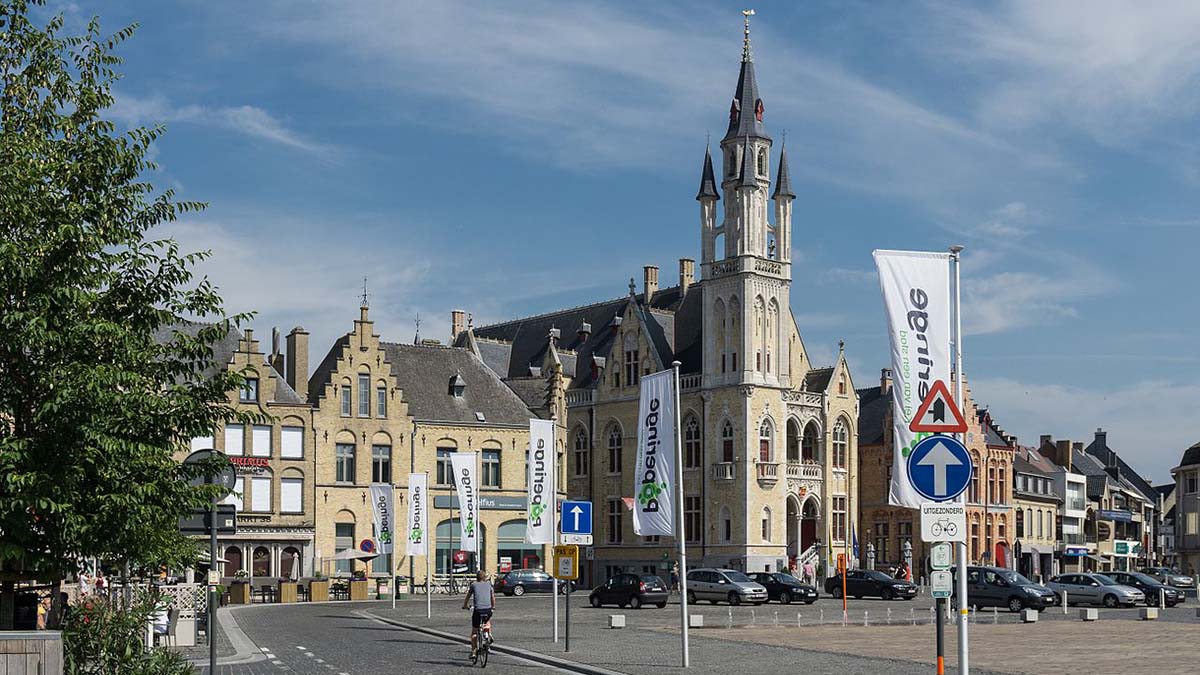
by Keith Kellett
From the outside, No. 43, Gasthuisstraat, in the Belgian town of Poperinge looks like a typical 18th Century town-house of a type commonly found in the Low Countries, but, it’s famous world-wide. Outside fly the flags of Britain and Belgium, and a sign tells some of the story:
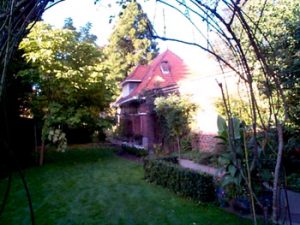 TALBOT HOUSE
TALBOT HOUSE
1915 — ?
EVERY-MAN’S CLUB
I was in Poperinge researching an article about the war, and wanted to see the building my Grandfather had often spoken of. Being an ex-Serviceman, I’m well aware of the work that the Toc H organization, which sprang from this ‘club’, do. I found out more when I went inside, to find the interior in more or less the same condition as it was at the war’s end in 1918.
During the First World War, Poperinge was a place of relative safety, where soldiers could be withdrawn from the nearby front-line trenches of Flanders for a brief respite. Shops, cafés, cinemas and theatres were all open for the relaxing troops. But, the Rev. Philip Clayton, an Army chaplain, realized some soldiers needed something which wasn’t readily available in ‘Pops’. He sought to provide a ‘home from home’, where a man could sit quietly with his thoughts, maybe read, or write a letter home, have a quiet conversation over a cup of tea with a friend … or, if he wished, pray.
‘Tubby’ Clayton and his friend, the Rev. Neville Talbot, rented a house from hop merchant Maurice Coevoet and set up their ‘Every-Man’s Club’ where all soldiers, irrespective of rank were welcome. This was almost unknown at the time; Grand-dad especially treasured this, as it was one place he could talk frankly to his men, and they to him.
They called it ‘Talbot House’ after Neville’s younger brother, Lt. Gilbert Talbot, killed at Hooge some months earlier. As soldiers will, they reduced the name to initials only, soon becoming, in the argot of Army signallers ‘Toc H’.
“Nowadays” said the curator, having sat me down with a cup of tea in the true Toc H fashion “they’d probably call it the Tango Hotel.”
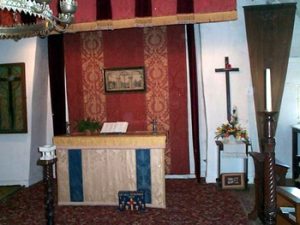 Toc H operated the ‘Robin Hood principle’. Officers’ Messes (the ‘rich!’) frequently ‘donated’ items of furniture, and other useful equipment for use in the club (by the ‘poor’), often without their knowledge or permission! This was known as ‘scrounging’. It quickly became, in the words of one soldier ‘an oasis in a world gone crazy’ offering a short respite, not only from the War, but from the authority of the Army.
Toc H operated the ‘Robin Hood principle’. Officers’ Messes (the ‘rich!’) frequently ‘donated’ items of furniture, and other useful equipment for use in the club (by the ‘poor’), often without their knowledge or permission! This was known as ‘scrounging’. It quickly became, in the words of one soldier ‘an oasis in a world gone crazy’ offering a short respite, not only from the War, but from the authority of the Army.
‘All Rank Abandon, Ye Who Enter Here’ says the sign on the door of Tubby Clayton’s room, paraphrasing the sign over the gates of Hell in Dante’s Inferno. That’s one example of the amusing signs around the place. As a great fan of amusing signs, I loved them. There had to be rules, but Tubby saw no reason to get heavy about them.A sign by the front door says ‘To Pessimists-Way Out’, with a pointing finger indicating the door.‘The Boss Isn’t Always Right …but he is always THE BOSS!’ reads another. That, I thought, was definitely one for the office wall.
A peculiarity of Toc H was that ‘the foundations are in the loft’. After much work, and not a little ‘scrounging’ by the Queen’s Westminster Rifles, who were billeted next door, the attic was converted into a chapel, usually simply referred to as the ‘Upper Room’. The altar was converted from a carpenter’s bench, which Tubby found in a garden shed. But, for hundreds of worshipping soldiers, it became ‘the shrine of the whole (Ypres) Salient’.
Food was always available, although you had to cook it yourself. Or, a cup of tea, a smoke or a companionable game of cards or billiards could be found. Sing-songs were popular. When Tubby put it about that a piano might be a welcome addition to the house’s inventory, resourceful soldiers ‘scrounged’ three. Books could be borrowed from the library. But, all the notices in the world couldn’t prevent ‘scrounging’ so a system was devised whereby a soldier borrowing a book left his cap as deposit, without which he couldn’t leave the building.
An important feature was ‘Friendship’s Corner’. Here, on a bulletin board, soldiers could leave messages for, or make enquiries for their friends. ‘Come Into the Garden and Forget About the War’. Toc H was always proud of its restful ‘English Garden’, and still is to this day. To modern eyes, it looks rather ordinary, but, nevertheless, was much appreciated; ‘ The largest room in the Old House’ wrote Clayton.
‘Men were everywhere, like lizards basking in the sun and half asleep’ he recorded. Another visitor said, in a letter home ‘The grass was almost unbelievably green; there were flowers and in a tree top, a bird was singing’.
Those were sights rarely seen in the Ypres salient at that time.
The garden was packed to capacity on 23rd July 1917, when Dr. Cosmo Lang, the Archbishop of York, preached a sermon on the eve of the Battle of Passchendaele.
The Toc H garden was only a short way in miles from the trenches. Indeed, shortly after Clayton posted his ‘Come Into the Garden’ notice, a German shell landed nearby causing one death, and damage for which Clayton subsequently received a bill from the house’s owner! But, in other respects, it was half a world away, and it still is.
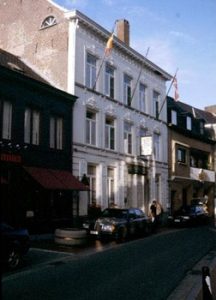 Many people make pilgrimages to the Ypres Salient to visit the battlefields, museums, cemeteries and memorials. Some of them come to ‘Pops’ and Toc H, which has been preserved in almost exactly the state it was in the Great War, but still provides inexpensive hostel accommodation.
Many people make pilgrimages to the Ypres Salient to visit the battlefields, museums, cemeteries and memorials. Some of them come to ‘Pops’ and Toc H, which has been preserved in almost exactly the state it was in the Great War, but still provides inexpensive hostel accommodation.
The garden is still there, kept just as ‘Tubby’ Clayton would have liked it, and it’s still available for visitors to go into, and, for a short while, ‘forget about the war’
It wasn’t only soldiers who benefited from the facilities offered by Toc H. They frequently held parties and treats for the children of Poperinge. ‘They gave us cheese and toffees’ wrote Poperinge resident Jeanne Battheu. “ we did not know what toffees were, but soon found out when we tasted them.’
In 1917, when the activities seriously overcrowded the house, Tubby ‘seized’ the hop store next door, which became the ‘Concert Hall’. Several months afterwards, they say, he asked permission.
After the war, Toc H was handed back to its owner, but, ten years later, Major Paul Slessor, representing Lord Wakefield of Hythe negotiated the purchase of the house, and its presentation to the Talbot House Association. Major Slessor then sought to restore it to the way it was under Tubby’s benevolent rule, in which state it’s been ever since, except for during the Second World War, when the memorabilia were spirited away and hidden, to be returned after the war.
For many years, Toc H served as a hostel and rendezvous point for veterans revisiting the old battle-grounds, or for people seeking the graves of their friends and relatives. The name lives on with the Toc H movement, a charitable Christian fellowship and community service organization.
And, Toc H itself is still a reasonably-priced self-catering hostel, usually used by those visiting the battlefields. I did regret that, because my accommodation was already arranged, I didn’t spend the night there. Casual visitors are always welcome to look around It’s been preserved almost exactly as it was in 1918, but although the custodian is called the ‘curator’, one thing Toc H is not is a ‘museum’.
If You Go:
www.talbothouse.be
www.greatwar.co.uk
About the author:
Having written as a hobby for many years while serving in the Royal Air Force, Keith Kellett saw no reason to discontinue his hobby when he retired. He has published in many UK and overseas print magazines, and on the Web.
Photo credits:
Poperinge Town Hall and Grote Markt by Kenneth C. Zirkel / CC BY-SA
All other photos are by Keith Kellett.

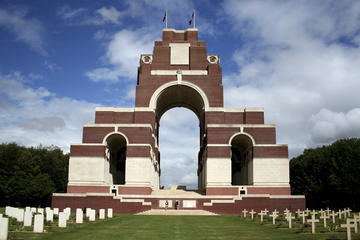


Leave a Reply
You must be logged in to post a comment.